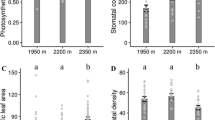Abstract
Demographic and reproductive schedules were compared among five populations of a cleistogamous annual,Impatients noli-tangere L., occurring in habitats with contrasting moisture and/or light environments. In all populations, flowering extended for 2–3 months during which light environment and mortality changed. Seasonal patterns of growth and mortality were significantly different among the five populations studied. The beginning and duration of flowering and the ratio of chasmogamous flowers to cleistogamous ones were also significantly different among populations. An experiment was conducted under different light conditions (open and closed) to separate the genetic and environmental components of the variation in reproductive traits observed among populations ofI. noli-tangere. Transplanted plants showed significant among-population variation in flowering time, as is observed in natural populations, suggesting genetic differentiation among populations of this species. On the other hand, the ratio of chasmogamous flowers did not differ among plants transplanted from three populations. Based on these results, the authors suggest that facultative cleistogamy is a conditional strategy under seasonally changing environments.
Similar content being viewed by others
References
Abrahamson W. G. &Hershey G. J. (1977) Resource allocations and growth ofImpatients capensis (Balsaminaceae) in two habitats.Bulletin of the Torrey Botanical Club 104: 160–164.
Cohen D. (1971) Maximizing final yield when growth is limited by time or by limiting resources.Journal of Theoretical Biology 33: 299–307.
Hiratsuka A. &Inoue O. (1988) Dispersability of dimorphic seeds inImpatiens noli-tangere andImpatiens textori (Balsaminaceae).Ecological Review 21: 157–161.
Kato M. (1988) Bumblebee visits toImpatiens spp.: Pattern and efficiency.Oecologia 76: 364–370.
King D. &Roughgarden J. (1982a) Multiple switches between vegetative and reproductive growth in annual plants.Theoretical Population Biology 21: 194–204.
King D. &Roughgarden J. (1982b) Graded allocation between vegetative and reproductive growth for annual plants in growing seasons of random length.Theoretical Population Biology 22: 1–6.
Lloyd D. G. (1983) Variation strategies of plants in heterogeneous environments.Biological Journal of the Linnean Society 21: 357–385.
Lord E. M. (1981) Cleistogamy: A tool for the study of floral morphogenesis, function and evolution.Botanical Review 47: 421–449.
Pyke D. A. &Thompson J. N. (1986) Statistical analysis of survival and removal rate experiments.Ecology 67: 240–245.
Rice W. R. (1989) Analyzing tables of statistical tests.Evolution 43: 223–225.
Rust R. W. (1977) Pollination inImpatients capensis andImpatiens pallida (Balsaminaceae).Bulletin of the Torrey Botanical Club 104: 361–367.
Schemske R. (1978) Evolution of reproductive characteristics inImpatients capensis (Balsaminaceae): The significance of cleistogamy and chasmogamy.Ecology 59: 596–613.
Schmitt J. &Ehrhardt D. (1987) A test of the sibcompetition hypothesis for the outcrossing advantage inImpatiens capensis.Evolution 41: 579–590.
Schmitt J., Ecleston J. &Ehrhardt D. W. (1987) Density dependent flowering phenology, outcrossing, and reproduction inImpatiens capensis.Oecologia 72: 342–347.
Schmitt J. &Gamble S. E. (1990) The effect of distance from the parental site on offspring performance and inbreeding depression inImpatiens capensis: A test of the local adaptation hypothesis.Evolution 44: 2022–2030.
Simpson R. L., Leck M. A. &Parker V. T. (1985) The comparative ecology ofImpatients capensis Meerb. (Balsaminaceae) in central New Jersey.Bulletin of the Torey Botanical Club 112: 295–311.
Sugita H. (1988)Impatients noli-tangere andImpatients textori (Balsaminaceae).Newton special issue (In Japanese)3: 46–47.
Waller D. W. (1979) The relative costs of self- and cross-fertilized seeds inImpatiens capensis (Balsaminaceae).American Journal of Botany 66: 313–320.
Waller D. W. (1980) Environmental determinants of outcrossing inImpatiens capensis (Balsaminaceae).Evolution 34: 747–761.
Waller D. W. (1982) Factors influencing seed weight inImpatiens capensis (Balsaminaceae).American Journal of Botany 69: 1470–1475.
Waller D. W. (1984) Differences in fitness between seedling derived from cleistogamous and chasmogamous flowers inImpatiens capensis.Evolution 38: 427–440.
Waller D. W. (1985) The genesis of size hierarchies in seedling populations ofImpatiens capensis Meerb.New Phytologist 100: 243–246.
Waller D. W. &Knight S. E. (1989) Genetic consequences of outcrossing in the cleistogamous annaual,Impatiens capensis. II. Outcrossing rates and genotypic correlations.Evolution 43: 860–869.
Wood C. E. (1975) The Balsaminaceae in the Southeastern United States.Journal of Arnold Arboretum 56: 413–426.
Author information
Authors and Affiliations
About this article
Cite this article
Masuda, M., Yahara, T. Reproductive ecology of a cleistogamous annual,Impatiens noli-tangere L., occurring under different environmental conditions. Ecol. Res. 9, 67–75 (1994). https://doi.org/10.1007/BF02347243
Received:
Accepted:
Issue Date:
DOI: https://doi.org/10.1007/BF02347243




